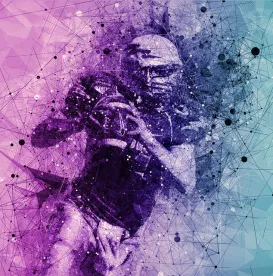In the United States, college athletics are as popular as professional sports, generating revenues of over $1 billion for the 2021 fiscal year. Despite this popularity, college athletes have long been classified by the National Collegiate Athletic Association (“NCAA”) as having amateur status.
The NCAA—which promulgates the rules and regulations pertaining to student-athletes’ participation and eligibility in college sports—defines an amateur as “someone who does not have a written or verbal agreement with an agent, has not profited above his/her actual and necessary expenses or gained a competitive advantage in his/her sport.”
Throughout the history of the NCAA, student-athletes were prohibited from making money from their name, image, or likeness—a concept commonly referred to as “NIL.” They could not be paid for signing autographs or entering into sponsorship deals, nor could they profit from the sales of jerseys bearing their name. Put differently, many of the ways in which professional athletes make their money were strictly off-limits to college players. But on July 1, 2021, the world of college sports transitioned into a new era, as the NCAA lifted the ban on player compensation and instituted an Interim NIL Policy.
This is the first of a three-part blog series that examines how, one year later, the various entities that operate within the world of college athletics, such as the players, businesses, and the academic institutions themselves, have adapted to the new reality and the dawn of NIL.
The Alston Case Changes the College Athletics Landscape
There has been a long-standing debate regarding the question of whether student-athletes should receive compensation in exchange for their participation in college sports. The NCAA’s position was that paying college athletes could erode the idealism of a player’s “amateur” status. NCAA member institutions harbored other concerns; they believed that allowing college players to be compensated would result in an inequitable recruiting process, as it could open the door to impropriety, such as a pay-for-play model. The players themselves were the biggest critics of the NCAA’s rules limiting student-athlete compensation, arguing that they are the most disadvantaged by such regulations. As such, it is no surprise that it was student-athletes who led the charge that ushered in the NIL movement.
Legal action seemed inevitable, and in 2019 a number of current and former college athletes sued the NCAA, in a case captioned NCAA v. Alston. There, the athletes sought to challenge the NCAA’s rules limiting the compensation that student-athletes could receive, arguing that they were in violation of federal antitrust law. At the time, student-athlete compensation was limited to education-related benefits. This consisted of tuition, fees, room and board, books, and cash for incidental expenses such as laundry. The court found the restrictions to be in violation of Section 1 of the Sherman Act. As a result, the court issued an injunction barring the NCAA from enforcing the rules.
The case was appealed by the NCAA, first to the Ninth Circuit—which affirmed the lower court’s ruling— and again to the Supreme Court in June 2021. Applying the “rule of reason” analysis, the Supreme Court agreed with the lower courts and found that the NCAA’s rules limiting player compensation were unreasonable because they substantially suppressed and destroyed the competition, thus violating the Sherman Act.
Affirming the ruling once more and determining the scope of the lower court’s permanent injunction to be appropriate, the Supreme Court remarked that “[n]owhere else in America can businesses get away with agreeing not to pay their workers a fair market rate… And under ordinary principles of antitrust law, it is not evident why college sports should be any different. The NCAA is not above the law.” Though the case did not specifically mention name, image, or likeness, the Supreme Court opinion set the stage for NIL laws to be passed across the nation.
On the heels of Alston and anticipating an imminent wave of legislation, the NCAA suspended its previous regulations and implemented an interim NIL policy that became effective on July 1, 2021. The NCAA continues to study the implications of NIL and is assessing how best to implement NIL regulations. They also expect for there to be some form of uniform legislation implemented across the nation sometime in the near future. Until then, they have opted to take a hands-off approach to rules concerning NIL activity.
Among other things, the interim regulations allow for the use of professional service providers, such as agents or lawyers, in the procurement of NIL deals. The interim policy prohibits only (1) “pay-for-play” and (2) “improper recruiting inducements” in connection with such engagements. The NCAA defines “pay-for-play” as “compensation for athletic participation or achievement (e.g., financial incentive based on points scored).” And “improper recruiting inducements” are defined as “compensation contingent on enrollment at a particular school.” In other words, the NCAA’s primary objective, for the time being, is to prevent NIL activity from being utilized as a vehicle to improperly recruit and retain college athletes at particular institutions.
Coming up in Part 2, we examine how the Alston ruling set the stage for a wave of NIL laws to be passed across the nation. In the third and final blog post of the series we will look at how schools, companies, and players alike have engaged with the world of NIL.




 />i
/>i

